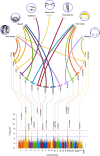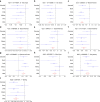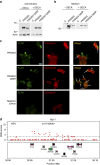A genome-wide association scan in admixed Latin Americans identifies loci influencing facial and scalp hair features
- PMID: 26926045
- PMCID: PMC4773514
- DOI: 10.1038/ncomms10815
A genome-wide association scan in admixed Latin Americans identifies loci influencing facial and scalp hair features
Abstract
We report a genome-wide association scan in over 6,000 Latin Americans for features of scalp hair (shape, colour, greying, balding) and facial hair (beard thickness, monobrow, eyebrow thickness). We found 18 signals of association reaching genome-wide significance (P values 5 × 10(-8) to 3 × 10(-119)), including 10 novel associations. These include novel loci for scalp hair shape and balding, and the first reported loci for hair greying, monobrow, eyebrow and beard thickness. A newly identified locus influencing hair shape includes a Q30R substitution in the Protease Serine S1 family member 53 (PRSS53). We demonstrate that this enzyme is highly expressed in the hair follicle, especially the inner root sheath, and that the Q30R substitution affects enzyme processing and secretion. The genome regions associated with hair features are enriched for signals of selection, consistent with proposals regarding the evolution of human hair.
Figures





Comment in
-
Evaluation of facial hair-associated SNPs: a pilot study on male Pakistani Punjabi population.Forensic Sci Med Pathol. 2023 Sep;19(3):293-302. doi: 10.1007/s12024-022-00515-z. Epub 2022 Aug 22. Forensic Sci Med Pathol. 2023. PMID: 35994154
References
-
- Bradley B. J. M., N.I. The primate palette: the evolution of primate coloration. Evol. Anthropol. 17, 97–111 (2008).
-
- Jablonski N. G. Skin: A Natural History Univ. of California Press (2006).
-
- Jablonski N. G. The naked truth. Sci. Am. 302, 42–49 (2010). - PubMed
-
- Loussouarn G. et al.. Worldwide diversity of hair curliness: a new method of assessment. Int. J. Dermatol. 46, (Suppl 1): 2–6 (2007). - PubMed
-
- Panhard S., Lozano I. & Loussouarn G. Greying of the human hair: a worldwide survey, revisiting the '50' rule of thumb. Br. J. Dermatol. 167, 865–873 (2012). - PubMed
Publication types
MeSH terms
Grants and funding
LinkOut - more resources
Full Text Sources
Other Literature Sources
Molecular Biology Databases

